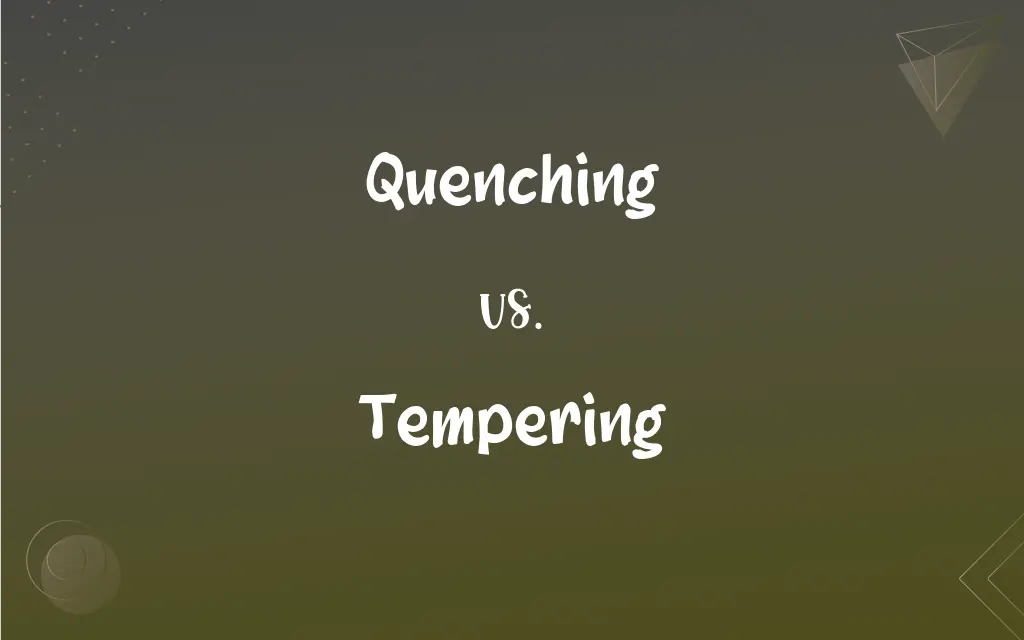Quenching vs. Tempering: What's the Difference?
Edited by Aimie Carlson || By Janet White || Published on March 4, 2024
Quenching rapidly cools metals for hardness; tempering heats quenched metals to reduce brittleness and increase toughness.

Key Differences
Quenching is a heat treatment process that involves rapidly cooling a metal to set its structure, thus increasing its hardness and strength. This sudden cooling is achieved by immersing the metal in a cooling medium such as water, oil, or air. The quenching process is critical in steel manufacturing, where it is used to harden steel by transforming its microstructure to a harder phase called martensite. Tempering, on the other hand, is a process that follows quenching. It involves reheating the quenched metal to a temperature below its critical point, then cooling it again at a controlled rate. The purpose of tempering is to adjust the properties of the metal by reducing the brittleness imparted by quenching and improving its toughness and ductility.
The quenching process can induce stresses and brittleness in the metal due to the rapid cooling and phase transformations. These effects are often undesirable, making the metal difficult to work with and increasing its susceptibility to cracking. Tempering is essential to alleviate the stresses and brittleness caused by quenching. By reheating the metal, tempering allows some of the hard martensitic structure to transform into tempered martensite, which is tougher and more stable.
Quenching and tempering are complementary heat treatment processes used to enhance the physical properties of metals. Quenching rapidly cools the metal to increase hardness, while tempering follows to improve toughness and reduce brittleness. Both processes are integral to the production of metals with tailored properties for various industrial applications, from construction to manufacturing tools and machinery.
Comparison Chart
Purpose
To harden and increase strength
To reduce brittleness, increase toughness
Process
Rapid cooling in water, oil, or air
Controlled reheating to below critical point
ADVERTISEMENT
Effect on Metal
Increases hardness, can induce brittleness
Reduces brittleness, improves ductility
Microstructural Change
Forms hard martensite
Transforms martensite to tempered martensite
Applications
Creating hard, wear-resistant surfaces
Making metals less brittle, more workable
Quenching and Tempering Definitions
Quenching
Heat treatment process to increase material hardness.
Quenching the metal part immediately improved its durability.
Tempering
Controlled heating to improve metal's mechanical properties.
Through tempering, the tool's resistance to impact was significantly increased.
ADVERTISEMENT
Quenching
Sudden cooling to lock in metal's microstructure.
The gear's performance was enhanced by precise quenching.
Tempering
Adjusting the properties of quenched metal.
The shaft was tempered to make it less prone to fracture.
Quenching
Rapid cooling of metal to harden it.
The blacksmith used quenching to harden the steel blade.
Tempering
Reheating quenched metal to reduce brittleness.
Tempering the blade ensured it wouldn't snap easily.
Quenching
Transforming metal to a harder phase through cooling.
Quenching transformed the soft iron into hard martensite.
Tempering
Heat treatment to achieve toughness in metal.
The tempering process gave the steel the perfect balance of hardness and flexibility.
Quenching
Process of cooling heated metal rapidly.
The quenching tank was prepared for the newly forged components.
Tempering
Enhancing ductility and toughness of hardened metal.
The tempering stage was crucial for the final quality of the springs.
Quenching
To put out (a fire, for example); extinguish.
Tempering
To modify by the addition of a moderating element; moderate
"temper its doctrinaire logic with a little practical wisdom" (Robert H. Jackson).
Quenching
To suppress; squelch
The disapproval of my colleagues quenched my enthusiasm for the plan.
FAQs
What does tempering do to metal?
Tempering reheats quenched metal to reduce brittleness and improve toughness.
Why is quenching followed by tempering?
Quenching hardens metal, making it brittle; tempering follows to restore some ductility and toughness.
What is quenching in metalworking?
Quenching is the rapid cooling of a metal to increase its hardness and strength.
How does tempering affect the microstructure of metal?
Tempering transforms martensite into tempered martensite, improving the metal's mechanical properties.
Is quenching applicable to all metals?
No, quenching is most effective on metals like steel that respond well to heat treatment.
What temperatures are used in tempering?
Tempering temperatures vary but are generally below the metal's critical point to avoid phase changes.
Can quenching cause metal to crack?
Yes, the rapid cooling during quenching can induce stresses that lead to cracking.
What mediums are used for quenching?
Water, oil, and air are common quenching mediums, each affecting the cooling rate differently.
How does the cooling rate affect quenching?
The cooling rate during quenching determines the hardness and brittleness of the metal.
Does tempering reduce the hardness of metal?
Yes, tempering slightly reduces hardness in exchange for increased toughness and ductility.
What factors influence the choice of quenching medium?
Material properties, desired hardness, and risk of distortion or cracking influence the choice.
How do quenching and tempering affect steel's performance?
Together, they enhance steel's wear resistance, durability, and resilience to impact.
Can tempering be repeated?
Yes, multiple tempering cycles can be used to fine-tune the properties of the metal.
What role does carbon content play in quenching?
Higher carbon content generally allows for greater hardness after quenching but also increases brittleness.
Is water quenching faster than oil quenching?
Yes, water provides a faster cooling rate than oil, leading to harder but more brittle metals.
How is tempering temperature chosen?
The tempering temperature is chosen based on the desired balance between hardness and toughness.
What are the risks of improper tempering?
Improper tempering can lead to inadequate toughness or excessive softening of the metal.
Can quenching be done in a vacuum?
Yes, vacuum quenching is a method used to minimize oxidation and improve cooling uniformity.
How long does the tempering process take?
Tempering times can vary from a few minutes to several hours, depending on the metal and desired properties.
What is the purpose of oil quenching?
Oil quenching provides a slower cooling rate than water, reducing the risk of cracking in some metals.
About Author
Written by
Janet WhiteJanet White has been an esteemed writer and blogger for Difference Wiki. Holding a Master's degree in Science and Medical Journalism from the prestigious Boston University, she has consistently demonstrated her expertise and passion for her field. When she's not immersed in her work, Janet relishes her time exercising, delving into a good book, and cherishing moments with friends and family.
Edited by
Aimie CarlsonAimie Carlson, holding a master's degree in English literature, is a fervent English language enthusiast. She lends her writing talents to Difference Wiki, a prominent website that specializes in comparisons, offering readers insightful analyses that both captivate and inform.































































